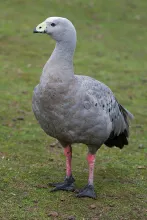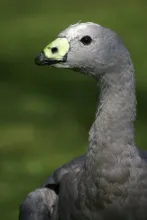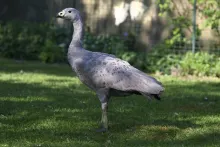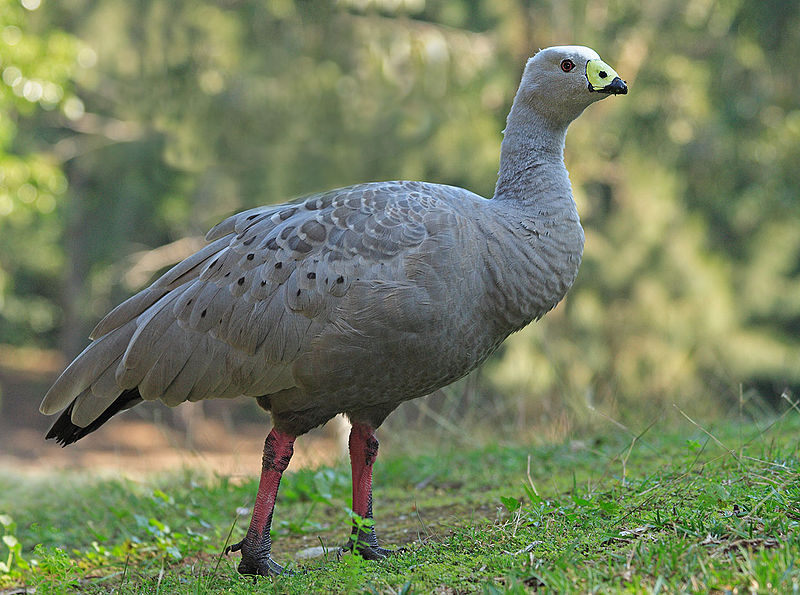
Cape Barren Goose (Cereopsis novaehollandiae)
Species name
- Dutch name:
- Cereopsisgans
- English name:
- Cape Barren Goose
- German name:
- Hühnergans
- French name:
- Céréopse cendré
- Scientific name:
- Cereopsis novaehollandiae
Scientific classification
- Order:
- Anseriformes
- Family:
- Anatidae
- Onderfamilie:
- Cereopsinae
- Genus:
- Cereopsis
Description
- Description:
Male:
Have almost uniformly grey plumage underparts are all grey, Upperparts are Grey as well but have rounded black spots, giving it a unique look. The tips of the tail and Wing feathers are blackish. Bill Black and bright greenish yellow cere. Head has a White crown and forehead. And reddish brown eyes. Legs are pink with black feet.Female:
Looks identical to male but smaller, best if compared in pair.Juvenile:
As Goslings They are little black and white striped balls of fluff. As they molt into fledging stage they start to look like adults but are paler and have heavier spotting on wing converts.
Standard Measurements
- Body Length (cm):
- The male (drake) of the Cape Barren Goose measures approximately 75-100 centimeters. The female measures approximately 75-100 centimeters.
- Body Weight (grams):
- The male will weight about 3760-6820 gram. The female will weight about 3760-6820 gram.
The weight is notoriously variable and can only be used as indication!
- Subspecies:
There are two subspecies:
- Cereopsis novaehollandiae novaehollandiae - Cape Barren Goose
- Cereopsis novaehollandiae grisea - Recherché Cape Barren Goose
- Note:
Cape Barren geese are hardy and easy to manage, but strong, aggressive including to humans (very aggressive in the breeding season) and good diggers. They require a separate spacious enclosure with good grazing and secure fencing well-buried to prevent their digging out. They are mainly terrestrial. Wheat and other grain, pellets, green food, and wholemeal bread should supplement good grazing; lucern (alfalfa) pellets may also be used.
Cape Barren geese are fairly easily bred but variable - some pairs are prolific. In Australia May to August (winter) is the common breeding season for captive birds. In the Northern hemisphere they lay usually November to April (peak December to January), so they often nest in mid-winter. A kennel-type box is often used but they also lay in open or close ground cover. A shelter area such as a large kennel-type structure should be provided sufficient for winter nesting, frost-proof and draught-proof for winter-hatched goslings and this may be supplemented by some good natural vegetation cover.
Both parents will defend the nest and young; fresh lettuce and sprouting grain should be provided to goslings as part of their diet. Goslings must be removed once reared. These birds frequently re-lay if the first clutch is removed for artificial incubation. Some pairs are unreliable parents and removal of eggs and hand rearing may be prefered for such birds. Goslings should be encouraged to exercise, and too rapid growth avoided to reduce the risk of Angel Wing. Unlike their parents, goslings readily make use of a water area. Both artificial hatching and rearing and broodies may be used; care should be taken to avoid imprinting on humans - imprinted males are liable to become particularly aggressive adults.
N.B. handle these birds with care as they may bite, scratch with their nails and bash with their wings. "Kick boards" (wooden boards on handles) have been used successfully and safely to move these geese without needing to catch and carry them.
- Breeding:
- The female Cape Barren Goose usually lays from 3-6 creamy white and not shiny eggs and incubates them for 28-31 days.
- Artificial incubating:
The ideal relative humidity for incubating most waterfowl eggs is 55% (ground nesters) and 40% (cavity nesters). The temperature is usually 37.4°C. Set ventilation as recommended by the incubator manufacturer. Eggs must be turned, either automatically or by hand, a minimum of 4 times a day. As the duckling develops there is a loss of water from the egg and the air sac gets bigger. In normal development of an egg with a 28-31 days incubation, the air sac occupies about a third of it three days earlier. Cleanliness is vital and ideally eggs should be moved to a separate hatcher at this point, where the humidity should be increased to 65% and even higher once they have pipped internally.
- Bird banding:
- Recommended closed leg band ring size for the Cape Barren Goose is 20 mm.The leg band ring can only be applied on a young sheldgoose at around 14 days old.
- It doesn't matter what leg that you band, but it's good to have a consistent system. Suggested: Left leg = Female, Right leg = Male
- Maintenance food:
-



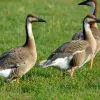

Lundi Regular with a protein content of 20%, valuable Spirulina and high-quality by-products is optimally balanced in its composition maintenance food for water ornamental fowl of all kinds. Especially green teal and Whistling ducks that are not dependent on a very high protein content, are well supplied.
Lundi Regular contains all the minerals and vitamins in full form that are important for the animals. Therefore also suitable as breeding food.


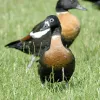


Floating full food for all sea ducks, green ducks, eider ducks and geese, especially in the moulting and breeding phase ideally suited. Packed with wholesome raw materials, natural vitamins and trace elements, this performance food with a protein content of 30% forms the basis for lifelong vitality.
